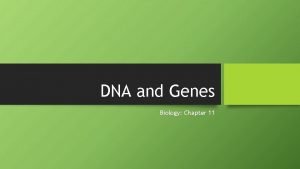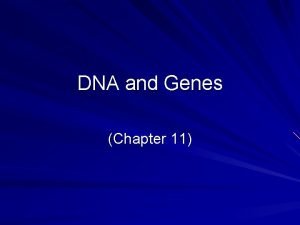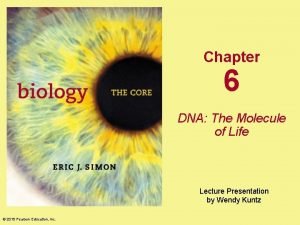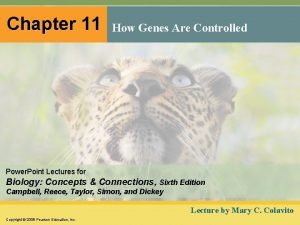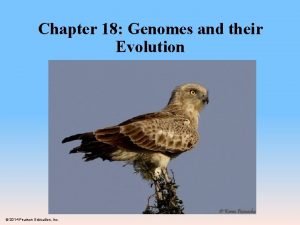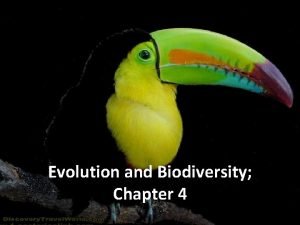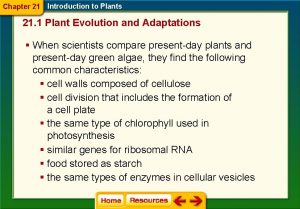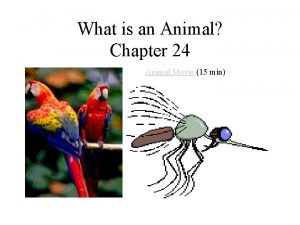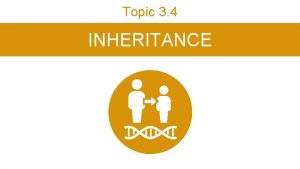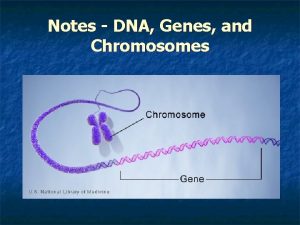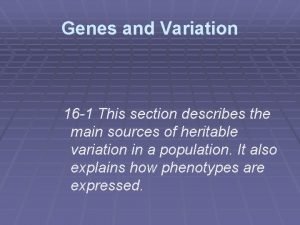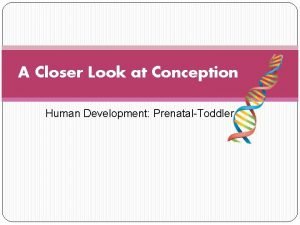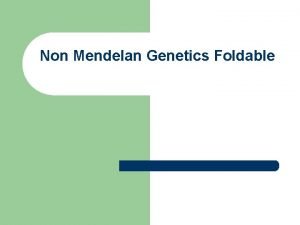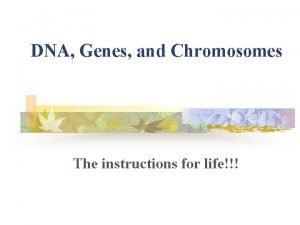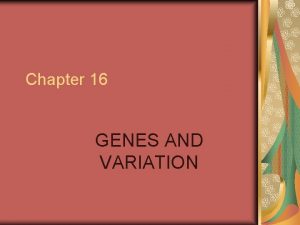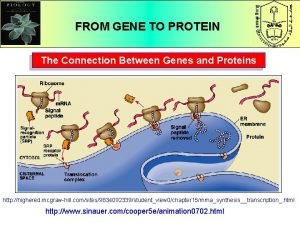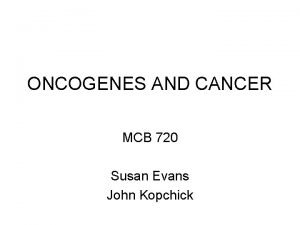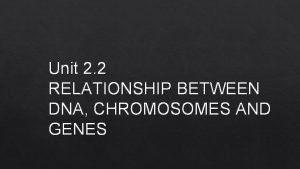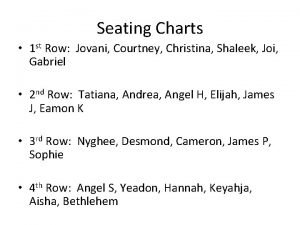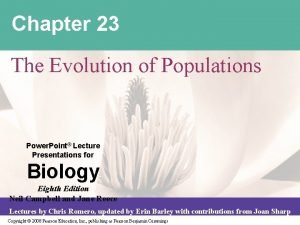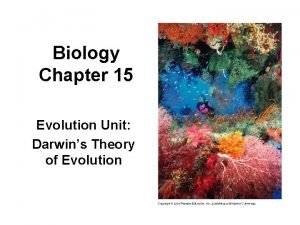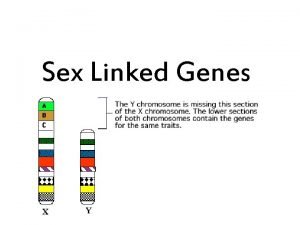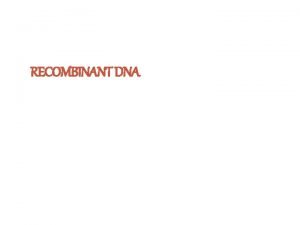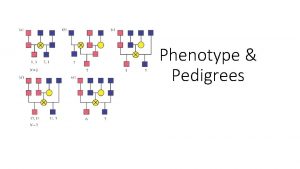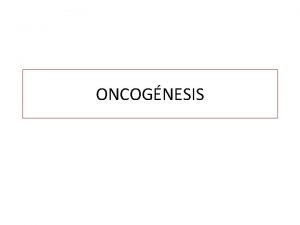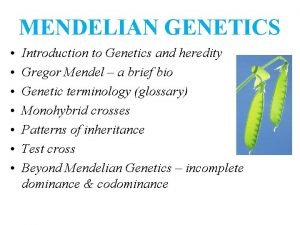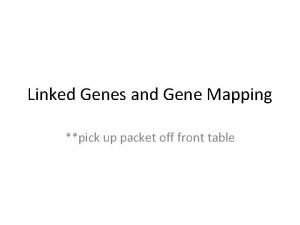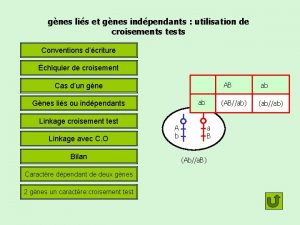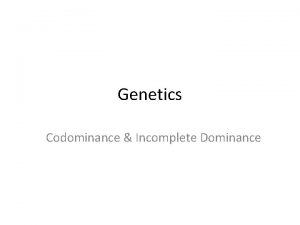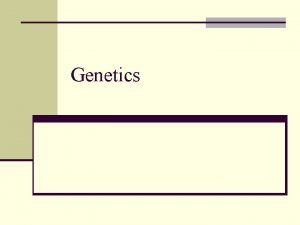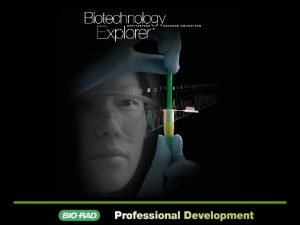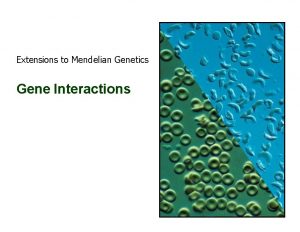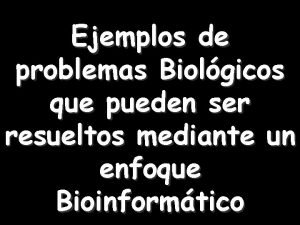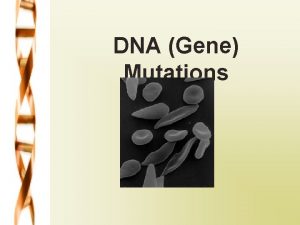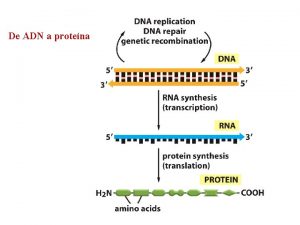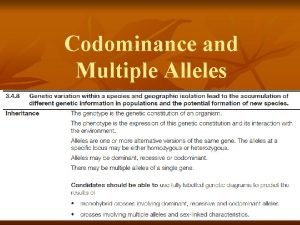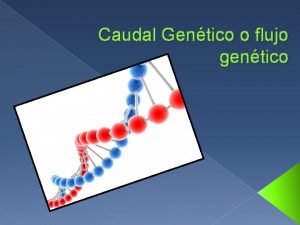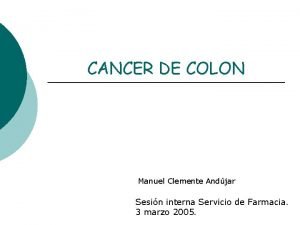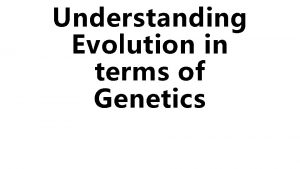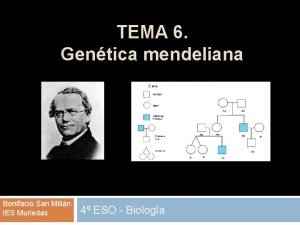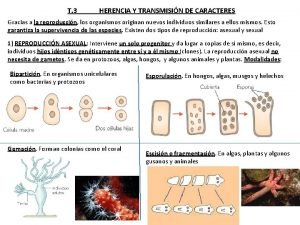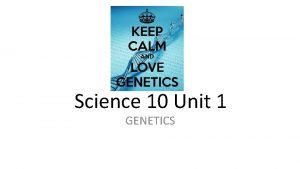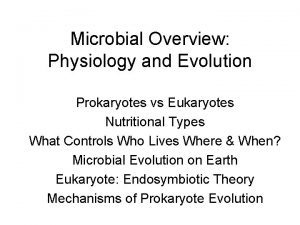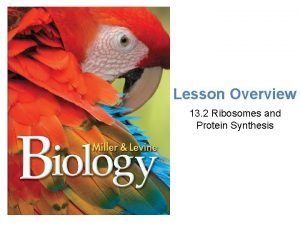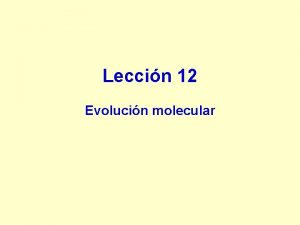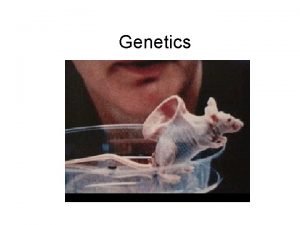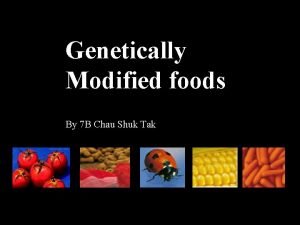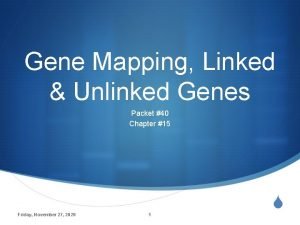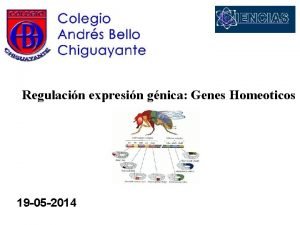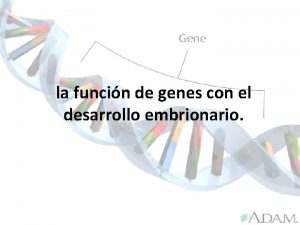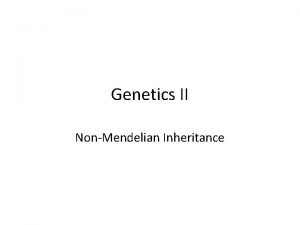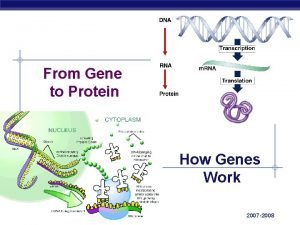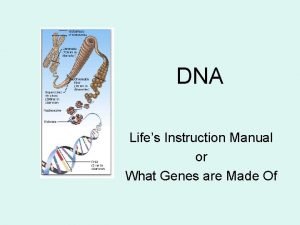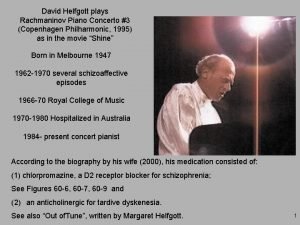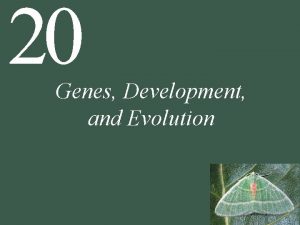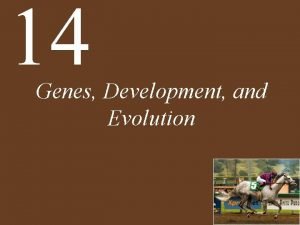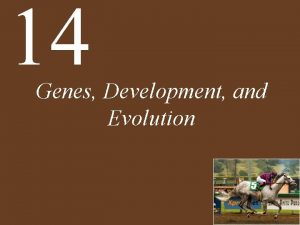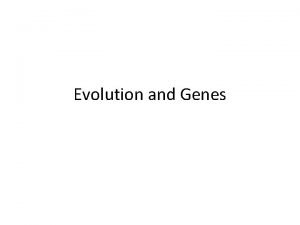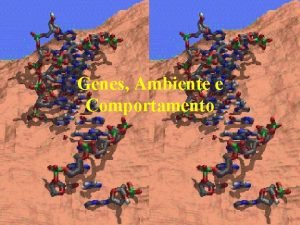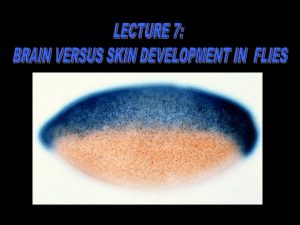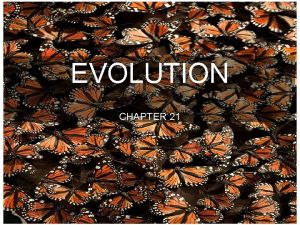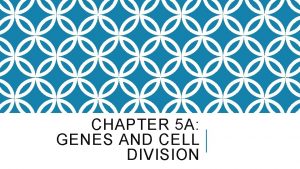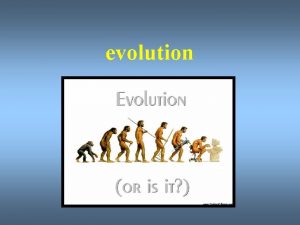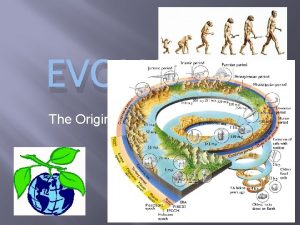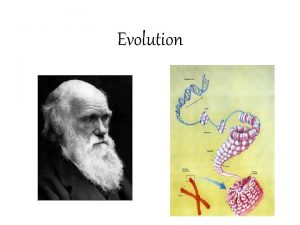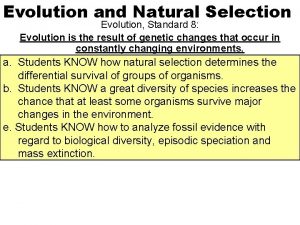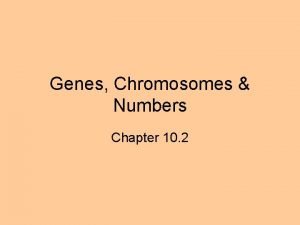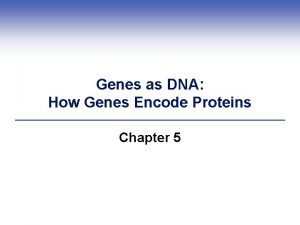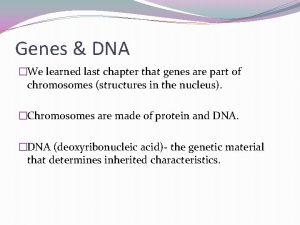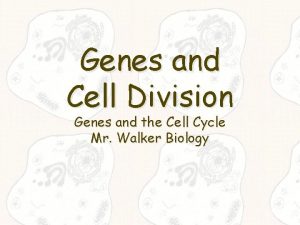14 Genes Development and Evolution Chapter 14 Genes











































































































- Slides: 107

14 Genes, Development, and Evolution

Chapter 14 Genes, Development, and Evolution Key Concepts • 14. 1 Development Involves Distinct but Overlapping Processes • 14. 2 Changes in Gene Expression Underlie Cell Differentiation in Development • 14. 3 Spatial Differences in Gene Expression Lead to Morphogenesis

Chapter 14 Genes, Development, and Evolution Key Concepts • 14. 4 Gene Expression Pathways Underlie the Evolution of Development • 14. 5 Developmental Genes Contribute to Species Evolution but Also Pose Constraints

Chapter 14 Opening Question Why are stem cells so useful?

Draw a picture of an anima that you can draw well. (side profile) Draw as much detail as you can and don’t show anyone. Pin it on the board

Concept 14. 1 Development Involves Distinct but Overlapping Processes Development—the process by which a multicellular organism undergoes a series of changes, taking on forms that characterize its life cycle. After the egg is fertilized, it is called a zygote. In its earliest stages, a plant or animal is called an embryo. The embryo can be protected in a seed, an egg shell, or a uterus.




Figure 14. 1 Development (Part 1)

Figure 14. 1 Development (Part 2)

http: //www. highschool. bfwpub. com/launchpad/pol 2 e/2764206 /launchpad/item/hillis 2 e_activities_34? mode=Preview&include. Discussion=False&re nder. FNE=True&render. In=fne

Concept 14. 1 Development Involves Distinct but Overlapping Processes Four processes of development: • Determination sets the fate of the cell • Differentiation is the process by which different types of cells arise • Morphogenesis is the organization and spatial distribution of differentiated cells • Growth is an increase in body size by cell division and cell expansion

Concept 14. 1 Development Involves Distinct but Overlapping Processes As zygote develops, the cell fate of each undifferentiated cell drives it to become part of a particular type of tissue. Experiments in which specific cells of an early embryo are grafted to new positions on another embryo show that cell fate is determined during development.


http: //www. highschool. bfwpub. com/launchpad/pol 2 e/2764206 /launchpad/item/bsi__6 E 83 E 1 FF__6488__445 B__9 FCF__54 DF 41646207? mode=P review&include. Discussion=False&render. FNE=True&render. In=fne

Figure 14. 2 A Cell’s Fate Is Determined in the Embryo

Concept 14. 1 Development Involves Distinct but Overlapping Processes Determination is influenced by changes in gene expression as well as the external environment. Determination is a commitment; the final realization of that commitment is differentiation. Differentiation is the actual changes in biochemistry, structure, and function that result in cells of different types.

Figure 14. 3 Cloning a Plant (Part 1)

Figure 14. 3 Cloning a Plant (Part 2)

Concept 14. 1 Development Involves Distinct but Overlapping Processes Determination is followed by differentiation —under certain conditions a cell can become undetermined again. It may become totipotent—able to become any type of cell. Plant cells are usually totipotent but can be induced to dedifferentiate into masses of calli, which can be cultured into clones. Genomic equivalence—all cells in a plant have the complete genome for that plant.


Concept 14. 1 Development Involves Distinct but Overlapping Processes In animals, nuclear transfer experiments have shown that genetic material from a cell can be used to create cloned animals. The nucleus is removed from an unfertilized egg, forming an enucleated egg. A donor nucleus from a differentiated cell is then injected into the enucleated egg. The egg divides and develops into a clone of the nuclear donor.

https: //www. youtube. com/watch? v=K 7 D 6 i. A 7 b. ZG 0

http: //learn. genetics. utah. edu/content/clonin g/clickandclone/

Figure 14. 4 Cloning a Mammal (Part 1)

Figure 14. 4 Cloning a Mammal (Part 2)

Figure 14. 4 Cloning a Mammal (Part 4)

Concept 14. 1 Development Involves Distinct but Overlapping Processes As in plants, no genetic information is lost as the cell passes through developmental stages—genomic equivalence. ie, No genetic info is lost. Practical applications for cloning: • Expansion of numbers of valuable animals • Preservation of endangered species • Preservation of pets

Concept 14. 1 Development Involves Distinct but Overlapping Processes In plants, growing regions contain meristems —clusters of undifferentiated, rapidly dividing stem cells. Plants have fewer cell types (15– 20) than animals (as many as 200). In mammals, stem cells occur in most tissues, especially those that require frequent replacement—skin, blood, intestinal lining. These stem cells are used to replace cells lost due to wear and tear. There about 300 cell types in mammals.

Concept 14. 1 Development Involves Distinct but Overlapping Processes Stem cells in some mammalian tissues are multipotent—they produce cells that differentiate into a few cell types. Hematopoietic stem cells produce red and white blood cells. Mesenchymal stem cells produce bone and connective tissue cells. Both types are found in the bone marrow. Multipotent cells are differentiated on an as

Concept 14. 1 Development Involves Distinct but Overlapping Processes Multipotent stem cells differentiate “on demand. ” Stem cells in the bone marrow differentiate in response to certain signals, which can be from adjacent cells or from the circulation. This is the basis of a cancer therapy called hematopoietic stem cell transplantation (HSCP).

Figure 14. 5 Multipotent Stem Cells

Concept 14. 1 Development Involves Distinct but Overlapping Processes Therapies that kill cancer cells can also kill other rapidly dividing cells such as bone marrow stem cells. The stem cells are removed and stored during therapy, and then returned to the bone marrow. The stored stem cells retain their ability to differentiate.


Concept 14. 1 Development Involves Distinct but Overlapping Processes Pluripotent cells in the blastocyst (Blastula) embryonic stage retain the ability to form all of the cells in the body, but they cannot form an entire embryo. In mice, embryonic stem cells (ESCs) can be removed from the blastocyst and grown in laboratory culture almost indefinitely. ESCs in the laboratory can also be induced to differentiate by specific signals, such as Vitamin A to form neurons or growth factors to form blood cells.

Concept 14. 1 Development Involves Distinct but Overlapping Processes ESC cultures may be sources of differentiated cells to repair damaged tissues, as in diabetes or Parkinson’s disease. ESCs can be harvested from human embryos conceived by in vitro fertilization, with consent of the donors. However: • Some people object to the destruction of human embryos for this purpose • The stem cells could provoke an immune response in a recipient

Concept 14. 1 Development Involves Distinct but Overlapping Processes Induced pluripotent stem cells (i. PS cells) can be made from skin cells: • Microarrays are used to find genes uniquely expressed at high levels in ESCs. • The genes are inserted into a vector for genetic transformation of skin cells—skin cells express added genes at high levels. • The transformed cells become i. PS cells and can be induced to differentiate into many tissues.

Concept 14. 2 Changes in Gene Expression Underlie Cell Differentiation in Development Major controls of gene expression in differentiation are transcriptional controls. While all cells in an organism have the same DNA, it can be demonstrated with nucleic acid hybridization that differentiated cells have different m. RNAs.

Concept 14. 2 Changes in Gene Expression Underlie Cell Differentiation in Development… Two ways to make a cell transcribe different genes: • Asymmetrical factors that are unequally distributed in the cytoplasm may end up in different amounts in progeny cells • Differential exposure of cells to an inducer

https: //www. blendspace. com/lessons/cr. Rmc d. XVSZg-yw/evo-devo

Concept 14. 2 Changes in Gene Expression Underlie Cell Differentiation in Development Polarity—having a “top” and a “bottom” may develop in the embryo. An early event in embryonic development is often the establishment of an axis that relates to the body plan of an organism. The animal pole is the top, the vegetal pole is the bottom. Polarity can lead to determination of cell fates early in development.

In-Text Art, Ch. 14, p. 270 Bottom becomes a normal urchin, top half nothing at all. 2 normal, small sea urchins

Concept 14. 2 Changes in Gene Expression Underlie Cell Differentiation in Development Polarity was demonstrated using sea urchin embryos at the 8 cell stage. . If an eight-cell embryo is cut vertically, it develops into two normal but small embryos. If the eight-cell embryo is cut horizontally, the bottom develops into a small embryo, the top does not develop.

Concept 14. 2 Changes in Gene Expression Underlie Cell Differentiation in Development Model of cytoplasmic segregation states that cytoplasmic determinants are distributed unequally in the egg. The cytoskeleton contributes to distribution of cytoplasmic determinants: • Microtubules and microfilaments have polarity. • Cytoskeletal elements can bind certain proteins.

Figure 14. 8 The Concept of Cytoplasmic Segregation (Part 1) Shows unequal distribution of cytop Plasmic determinants in the egg, leading to the creation of Animal and Vegetal poles. After division, uneven distribution is maintained. These 2 cell still have the same fate at this point. After the next division, the cells at the vegetal poles contain the cytoplasmic matrerial while the top have none. At this point, the upper cells and lower cells have Different fates.

http: //bcs. whfreeman. com/pol 2 e/default. asp - 940573__943472__

Concept 14. 2 Changes in Gene Expression Underlie Cell Differentiation in Development In sea urchin eggs, a protein binds to the growing end (+) of a microfilament and to an m. RNA encoding a cytoplasmic determinant. As the microfilament grows toward one end of the cell, it pulls the m. RNA along. The unequal distribution of m. RNA results in unequal distribution of the protein it encodes.

Concept 14. 2 Changes in Gene Expression Underlie Cell Differentiation in Development Induction refers to the signaling events in a developing embryo. Cells influence one another’s developmental fate via chemical signals called “INDUCERS” and signal transduction mechanisms. Exposure to different amounts of inductive signals can lead to differences in gene expression. Thus, proximity of cell to inducer and concentration of the inducers is critical.

Concept 14. 2 Changes in Gene Expression Underlie Cell Differentiation in Development In C. elegans, the cell divisions from the fertilized egg to the 959 adult cells can be followed. Nematodes are hermaphroditic and contain male and female reproductive organs. Eggs are laid through a pore, the vulva. During development, a single anchor cell induces the vulva to form from six cells on the ventral surface of the worm.

Figure 14. 9 Induction during Vulval Development in Caenorhabditis elegans (Part 1)

Concept 14. 2 Changes in Gene Expression Underlie Cell Differentiation in Development The anchor cell secretes the primary inducer, LIN 3 protein, which diffuses out of the anchor cell and creates a concentration gradient relative to the other adjacent cells. The cell closest to the anchor cell receives the highest amounts of LIN 3. It becomes the primary vulval precursor cell. The primary precursor cell that received the most LIN -3 then secretes a secondary inducer (lateral signal) that acts on its neighbors. These primary and secondary inducers activate or deactivate select gene sets

The neighboring 2 cells that receive smaller amounts of the primary inducer LIN 3, as well as the secondary inducer that was released by the primary vulval precursor cell become secondary vulval precursor cells. Of the 6 original cells, 3 cells receive no primary or secondary inducers. They become epidermal cells. The gene expression patterns triggered by these molecular switches determine cell fates.

Figure 14. 9 Induction during Vulval Development in Caenorhabditis elegans (Part 2)

Concept 14. 2 Changes in Gene Expression Underlie Cell Differentiation in Development Induction involves the activation or inactivation of specific genes through signal transduction cascades in the responding cells. Example from nematode development: Much of development is controlled by the molecular switches that allow a cell to proceed down one of two alternative tracks.

Figure 14. 10 The Concept of Embryonic Induction Cell releases inducer molecules Thi cell binds higher Concentration of inducers The binding of inducers to Receptors causes the transcription Factors to move into the nucleus. A transcription factor binds A promoter, activating gene transcription Theresulting protein stimulates Cell differentiation, determining The cell’s fate. This cell binds fewer inducers No transcription

Concept 14. 3 Spatial Differences in Gene Expression Lead to Morphogenesis Pattern formation—the process that results in the spatial organization of tissues—linked with morphogenesis, creation of body form Spatial differences in gene expression depend on: • Cells in body must “know” where they are in relation to the body so arm buds appear where they should. • Cells must activate appropriate pattern of gene expression so arms actually grow from the arm buds, not something else.

Concept 14. 3 Spatial Differences in Gene Expression Lead to Morphogenesis Fate of a cell is often determined by where the cell is. Positional information comes in the form an inducer, a morphogen, which diffuses from one group of cells to another, setting up a concentration gradient. To be a morphogen: • It must directly affect target cells • Different concentrations of the morphogen result in different effects

Ohhhh Cute! Is there anything cuter than Baby fingers. But how does a thumb know to become a thumb, and a pinky?

Concept 14. 3 Spatial Differences in Gene Expression Lead to Morphogenesis The “French flag model” explains morphogens and can be applied to differentiation of the vulva in C. elegans and to development of vertebrate limbs. Vertebrate limbs develop from paddle-shaped limb buds—cells must receive positional information. Cells of the zone of polarizing activity (ZPA) secrete a morphogen called Sonic hedgehog (Shh). (Yeah, that’s right). It forms a gradient that determines the posterior–anterior axis.

Figure 14. 12 The French Flag Model (Part 1) Each cell has the potential to become red, white or blue. Their ultimate fate will depend on concentration of morphogen Exposure.

Figure 14. 12 The French Flag Model (Part 2) Front limb bud Rear limb bud The. ZPA cells release the Morphogen sonic hedge hog, which forms a concentration gradient. Lowest dose of SHH Thumb Highest dose of SHH pinky

Concept 14. 3 Spatial Differences in Gene Expression Lead to Morphogenesis Programmed cell death—apoptosis—is also important. Many cells and structures form and then disappear during development. Sequential expression of two genes called ced-3 and ced-4 (for cell death) are essential for apoptosis. Their expression in the human embryo guides development of fingers and toes.

In-Text Art, Ch. 14, p. 273

Concept 14. 3 Spatial Differences in Gene Expression Lead to Morphogenesis The fruit fly Drosophila melanogaster has a body made of different segments. The head, thorax, and abdomen are each made of several segments. 24 hours after fertilization a larva appears, with recognizable segments that look similar. The fates of the cells to become different adult segments are already determined.

Concept 14. 3 Spatial Differences in Gene Expression Lead to Morphogenesis Cytokinesis does not occur in the early Drosophila mitoses after fertilization. The zygote undergoes 12 mitotic divisions with no cytokinesis. The embryo until then is multinucleate, (1 cell with lots of nuclei )allowing for easy diffusion of morphogens. Experimental genetics were used: • Developmental mutant strains were identified. • Genes for mutations were identified. • Transgenic flies were produced to confirm the developmental pathway.

In-Text Art, Ch. 14, p. 276 (1)

Concept 14. 3 Spatial Differences in Gene Expression Lead to Morphogenesis Several types of genes are expressed sequentially to define the segments: • Maternal effect genes set up anterior– posterior and dorsal–ventral axes in the egg. • Segmentation genes determine boundaries between each segment and polarity of segments. • Hox genes determine what organ will be made at a given location.

Concept 14. 3 Spatial Differences in Gene Expression Lead to Morphogenesis Maternal effect genes produce cytoplasmic determinants in unequal distributions in the egg. Two genes—bicoid and nanos—determine the anterior–posterior axis. Their m. RNAs diffuse to the anterior end of the egg. After fertilization, the bicoid m. RNA is translated and the Bicoid protein diffuses away from the anterior end, establishing a gradient.

Concept 14. 3 Spatial Differences in Gene Expression Lead to Morphogenesis At sufficient concentration, bicoid stimulates transcription of the Hunchback gene. A gradient of that protein establishes the head. Nanos m. RNA is transported to the posterior end. Nanos protein inhibits translation of Hunchback. The result is no head at the posterior end. After the anterior and posterior ends are established, the next step is determination of segment number and locations.

In-Text Art, Ch. 14, p. 276 (2)

Concept 14. 3 Spatial Differences in Gene Expression Lead to Morphogenesis Segmentation genes determine properties of the larval segments. Three classes of genes act in sequence: • Gap genes organize broad areas along the axis • Pair rule genes divide embryo into units of two segments each • Segment polarity genes determine boundaries and anterior–posterior organization in individual segments

Figure 14. 13 A Gene Cascade Controls Pattern Formation in the Drosophila Embryo Maternal effect genes determine head and butt Gap genes organize segemnts into broad regions. Pair rules refine the segments Together, these 3 genes control expression of the HOX genes, which will define the identity of each segment.

Concept 14. 3 Spatial Differences in Gene Expression Lead to Morphogenesis Hox genes encode a family of transcription factors that are expressed in different combinations in the segments along the length of the embryo. They determine cell fates within each segment and direct cells to become certain structures, such as eyes or wings. They are “big picture” genes. They direct where to put a wing, but not how to make the wing. Hox genes are homeotic genes that are shared by all animals.

Concept 14. 3 Spatial Differences in Gene Expression Lead to Morphogenesis Clues to hox gene function came from homeotic mutants. Antennapedia mutation—legs grow in place of antennae. Bithorax mutation—an extra pair of wings grow on a segment of the thorax where wings do not typically occur. So the normal function of the Hox genes is to tell a segment what organ to grow.

Figure 14. 14 A Homeotic Mutation in Drosophila (Part 1)

Figure 14. 14 A Homeotic Mutation in Drosophila (Part 2)

Concept 14. 3 Spatial Differences in Gene Expression Lead to Morphogenesis Antennapedia and bithorax genes have a common 180 -bp sequence—the homeobox, that encodes a 60 -amino acid sequence called the homeodomain. The homeodomain binds to a specific DNA sequence in promoters of target genes.

http: //bcs. whfreeman. com/pol 2 e/default. asp - 940573__943473__

Concept 14. 4 Gene Expression Pathways Underlie the Evolution of Development Discovery of developmental genes allowed study of other organisms. The homeobox is also present in many genes in other organisms, showing a similarity in the molecular events of morphogenesis. Evolutionary developmental biology (evodevo) is the study of evolution and developmental processes.

Concept 14. 4 Gene Expression Pathways Underlie the Evolution of Development Principles of evo-devo: • Many groups of animals and plants share similar molecular mechanisms for morphogenesis and pattern formation, including a toolkit of regulatory molecules that control gene expression. • The molecular pathways that determine different developmental processes are able to operate independently in different tissues and body regions— called modularity. This means that evolutionry change can occur in independendent “modules”. Incremental changes may be dramatic on certain modules, with little to no change elsewhere.


Concept 14. 4 Gene Expression Pathways Underlie the Evolution of Development • Changes in location and timing of expression of particular genes are important in the evolution of new body forms and structures. • Development produces morphology, and morphological evolution occurs by modification of existing developmental pathways—not through new mechanisms.

Concept 14. 4 Gene Expression Pathways Underlie the Evolution of Development Mapping genomes from throughout the animal world has revealed that diverse animals share molecular pathways for gene expression in development. Fruit fly genes have mouse and human orthologs for developmental genes. These genes are arranged on the chromosome in the same order as they are expressed along the anterior–posterior axis of their embryos Head end 1 st—the positional information has been conserved.

Figure 14. 15 Regulatory Genes Show Similar Expression Patterns

Concept 14. 4 Gene Expression Pathways Underlie the Evolution of Development Certain developmental mechanisms, controlled by specific DNA sequences, have been conserved over long periods during the evolution of multicellular organisms. These sequences comprise the genetic toolkit, which has been modified over the course of evolution to produce the diversity of organisms in the world today.


Concept 14. 4 Gene Expression Pathways Underlie the Evolution of Development In an embryo, genetic switches integrate positional information and play a key role in making different modules develop differently. Genetic switches control the activity of Hox genes by activating each Hox gene in different zones of the body. The same switch can have different effects on target genes in different species, important in evolution.

Figure 14. 16 Segments Differentiate under Control of Genetic Switches (Part 1)

Figure 14. 16 Segments Differentiate under Control of Genetic Switches (Part 2)

Concept 14. 4 Gene Expression Pathways Underlie the Evolution of Development Modularity also allows the timing of developmental processes to be independent—heterochrony. Example: The giraffe’s neck has the same number of vertebrae as other mammals, but the bones grow for a longer period. The signaling process for stopping growth is delayed—changes in the timing of gene expression led to longer necks.

Figure 14. 17 Heterochrony in the Development of a Longer Neck

Bones grow due to the proliferation of cartilage producing cells called chondrocytes. Bone growth stops when a signal causes chondrocyte death. . In giraffes, the signaling is delayed, extending the growth period in the cervical vertebrae. So long necks evolved through changes in the timing of gene expression period, not through the acquisition of additional vertebrae.

Concept 14. 4 Gene Expression Pathways Underlie the Evolution of Development Webbed feet in ducks result from an altered spatial expression pattern of a developmental gene. Duck and chicken embryos both have webbing, and both express BMP 4, a protein that instructs cells in the webbing to undergo apoptosis.

Concept 14. 4 Gene Expression Pathways Underlie the Evolution of Development In ducks, a gene called Gremlin, which encodes a BMP inhibitor protein, is expressed in webbing cells. In chickens, Gremlin is not expressed, and BMP 4 signals apoptosis of the webbing cells. Experimental application of Gremlin to chicken feet results in a webbed foot.

Figure 14. 18 Changes in Gremlin Expression Correlate with Changes in Hindlimb Structure

Concept 14. 5 Developmental Genes Contribute to Species Evolution but Also Pose Constraints Evolution of form has not been a result of radically new genes but has resulted from modifications of existing genes. Developmental genes constrain evolution in two ways: • Nearly all evolutionary innovations are modifications of existing structures. • Genes that control development are highly conserved, that is, the regulatory genes usually change very slowly over the course of evolution.

Concept 14. 5 Developmental Genes Contribute to Species Evolution but Also Pose Constraints Genetic switches that determine where and when genes are expressed underlie both development and the evolution of differences among species. Among arthropods, the Hox gene Ubx produces different effects. In centipedes, Ubx protein activates the Dll gene to promote the formation of legs. In insects, a change in the Ubx gene results in a protein that represses Dll expression, so leg formation is inhibited.

Figure 14. 19 A Mutation in a Hox Gene Changed the Number of Legs in Insects Mutation to UBX gene prevents leg growth on the abdominal segments

Concept 14. 5 Developmental Genes Contribute to Species Evolution but Also Pose Constraints Wings arose as modifications of existing structures. In vertebrates, wings are modified limbs. Organisms also lose structures. Ancestors of snakes lost their forelimbs as a result of changes in expression of Hox genes. Then hindlimbs were lost by the loss of expression of the Sonic hedgehog gene in limb bud tissue.

Figure 14. 20 Wings Evolved Three Times in Vertebrates

Concept 14. 5 Developmental Genes Contribute to Species Evolution but Also Pose Constraints Many developmental genes exist in similar form across a wide range of species. Highly conserved developmental genes make it likely that similar traits will evolve repeatedly: Parallel phenotypic evolution. Example: Three-spined sticklebacks (Gasterosteus aculeatus)

Concept 14. 5 Developmental Genes Contribute to Species Evolution but Also Pose Constraints Marine populations of sticklebacks return to freshwater to breed. Freshwater populations never go into saltwater environments. Freshwater populations have arisen many times from adjacent marine populations. Marine populations have pelvic spines and bony plates that protect them from predation. These are greatly reduced in freshwater populations.

Figure 14. 21 Parallel Phenotypic Evolution in Sticklebacks

Concept 14. 5 Developmental Genes Contribute to Species Evolution but Also Pose Constraints One gene, Pitx 1, is not expressed in freshwater sticklebacks, and spines do not develop. This same gene has evolved to produce similar phenotypic changes in several independent populations. It is therefore a good example of parallel phenotypic evolution.

Answer to Opening Question Stem cells are valuable because they are not differentiated and can develop into several kinds of cells. When fat stem cells are injected into a damaged area they respond to the environment of that tissue. Inducers in the environment determine the products of cell differentiation.

Figure 14. 22 Differentiation Potential of Stem Cells from Fat
 Linked genes and unlinked genes
Linked genes and unlinked genes Linked genes and unlinked genes
Linked genes and unlinked genes Factors of 15
Factors of 15 Stabilizing selection human birth weight
Stabilizing selection human birth weight Evolution of populations section 16-1 genes and variation
Evolution of populations section 16-1 genes and variation Chapter 11 dna and genes
Chapter 11 dna and genes Dna and genes chapter 11
Dna and genes chapter 11 Dna rna protein synthesis homework #2 dna replication
Dna rna protein synthesis homework #2 dna replication State the history of community development
State the history of community development The age of genes chapter 6
The age of genes chapter 6 Chapter 11 how genes are controlled reading guide
Chapter 11 how genes are controlled reading guide Chapter 2 risk factors behavior genes environment
Chapter 2 risk factors behavior genes environment Evolution and community ecology guided notes
Evolution and community ecology guided notes Chapter 21 section 1 plant evolution and adaptations
Chapter 21 section 1 plant evolution and adaptations Chapter 18 genomes and their evolution
Chapter 18 genomes and their evolution Chapter 5 evolution and community ecology
Chapter 5 evolution and community ecology Chapter 5 evolution and community ecology answer key
Chapter 5 evolution and community ecology answer key Chapter 4 biodiversity and evolution
Chapter 4 biodiversity and evolution Chapter 21 section 1 plant evolution and adaptations
Chapter 21 section 1 plant evolution and adaptations Coral reef phylum
Coral reef phylum Chapter 14 evolution a history and a process
Chapter 14 evolution a history and a process Dominant versus recessive
Dominant versus recessive Genes chromosomes and dna
Genes chromosomes and dna Learn genetics utah karyotype
Learn genetics utah karyotype Genetics is the study of heredity and variation
Genetics is the study of heredity and variation 16-1 genes and variation
16-1 genes and variation Chapter 16 evolution of populations
Chapter 16 evolution of populations Dominant and recessive genes
Dominant and recessive genes Chromosomes genes and basic genetics foldable answer key
Chromosomes genes and basic genetics foldable answer key Dna, genes and chromosomes relationship
Dna, genes and chromosomes relationship Section 16-1 genes and variation
Section 16-1 genes and variation What is the connection between genes and proteins
What is the connection between genes and proteins Oncogenes and tumor suppressor genes
Oncogenes and tumor suppressor genes What is the relationship between dna chromosomes and genes
What is the relationship between dna chromosomes and genes Susie roundpants
Susie roundpants Chapter 16 evolution of populations vocabulary review
Chapter 16 evolution of populations vocabulary review Chapter 17 evolution of populations answer key
Chapter 17 evolution of populations answer key Strengths and weaknesses of evolutionary theory page 386
Strengths and weaknesses of evolutionary theory page 386 Chapter 7 the evolution of living things answers
Chapter 7 the evolution of living things answers Chapter 23 the evolution of populations
Chapter 23 the evolution of populations Chapter 18 the evolution of invertebrate diversity
Chapter 18 the evolution of invertebrate diversity Chapter 17 darwins theory of evolution
Chapter 17 darwins theory of evolution Study guide chapter 16 section 1 primates answer key
Study guide chapter 16 section 1 primates answer key Chapter 15 darwin's theory of evolution section review 15-1
Chapter 15 darwin's theory of evolution section review 15-1 Chapter 15 darwin's theory of evolution section 15-1
Chapter 15 darwin's theory of evolution section 15-1 The evolution of exteriors chapter 6 answers
The evolution of exteriors chapter 6 answers Chapter 6 the evolution of exteriors
Chapter 6 the evolution of exteriors Chapter 23 the evolution of populations
Chapter 23 the evolution of populations Evolution of management thoughts
Evolution of management thoughts Chapter 16 primate evolution
Chapter 16 primate evolution The fruit of evolution chapter 15
The fruit of evolution chapter 15 Pseudocde
Pseudocde Advanced evolution chapter 4
Advanced evolution chapter 4 Advanced evolution chapter 8
Advanced evolution chapter 8 Natural selection
Natural selection Chapter 7 the evolution of living things answers
Chapter 7 the evolution of living things answers Chapter 5 diversity and human needs and development
Chapter 5 diversity and human needs and development Development that ended much development crossword
Development that ended much development crossword Where does the radial line development commonly used
Where does the radial line development commonly used X linked traits
X linked traits Tools of recombinant dna technology
Tools of recombinant dna technology Linked genes punnett square
Linked genes punnett square Phenotype pedigree chart
Phenotype pedigree chart Origen de la variabilidad
Origen de la variabilidad Telomerasa
Telomerasa Codominance
Codominance Que es el flujo genetico
Que es el flujo genetico Linked genes
Linked genes Nevertheless part 3
Nevertheless part 3 Genes located on the sex chromosomes
Genes located on the sex chromosomes échiquier de croisement gènes liés
échiquier de croisement gènes liés Herencia
Herencia Practice codominance and incomplete dominance
Practice codominance and incomplete dominance Bill nye genes worksheet
Bill nye genes worksheet Genes in a bottle
Genes in a bottle Complementary genes example
Complementary genes example Los transposones son genes móviles en un cromosoma
Los transposones son genes móviles en un cromosoma Ortologo
Ortologo Causes of mutation
Causes of mutation Genes estructurales
Genes estructurales Codominant allele
Codominant allele Chromosome 19
Chromosome 19 Caudal genetico
Caudal genetico Genes supresores de tumores
Genes supresores de tumores Genes for blood type
Genes for blood type Blood combinations
Blood combinations Plasmidos
Plasmidos Picture of natural selection
Picture of natural selection Ejemplos de herencia codominante
Ejemplos de herencia codominante Genes dominantes y recesivos
Genes dominantes y recesivos Genes to traits
Genes to traits Jumping genes
Jumping genes Genes contain instructions for assembling
Genes contain instructions for assembling Paralogo y ortologo
Paralogo y ortologo Honey bee chromosome
Honey bee chromosome Gmo tomatoes with fish genes
Gmo tomatoes with fish genes Linked vs unlinked genes
Linked vs unlinked genes Cdc genes
Cdc genes Cdc genes
Cdc genes Tumor suppressor genes
Tumor suppressor genes Genes hox
Genes hox Genes hox
Genes hox Holandric genes
Holandric genes Extending mendelian genetics answer key
Extending mendelian genetics answer key How genes work
How genes work Genes hox
Genes hox Genes are the in life's instruction manual
Genes are the in life's instruction manual Genes schizophrenia
Genes schizophrenia





